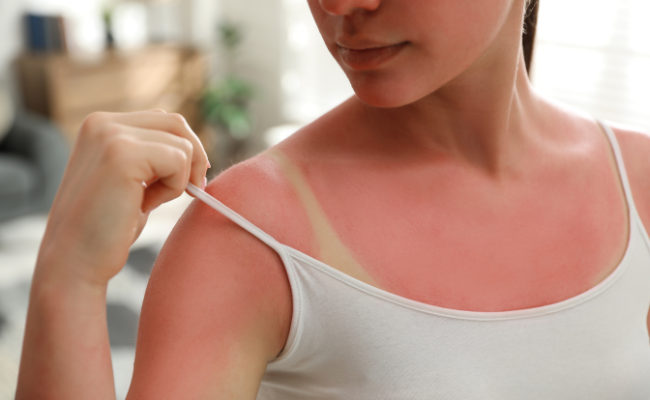How to Treat Sunburn?
- December 01, 2023
- No Comments

What is Sunburn?
Sunburn, resulting from excessive exposure to UV radiation, whether from the sun or tanning beds, brings about redness, pain, and peeling. Often perceived as a temporary discomfort, sunburn holds enduring consequences, contributing to premature aging and elevating the risk of skin cancer. Contrary to popular belief, acquiring a sunburn doesn't necessitate a day at the beach; routine outdoor activities like lunch breaks or gardening can pose risks, emphasizing the importance of consistent sunscreen use.
Recurrent sunburns not only cause immediate discomfort but also accelerate premature aging and heighten the risk of skin cancer. Therefore, adopting proactive measures for skin protection is crucial, not just during beach outings but also in everyday activities. This underscores the significance of integrating sunscreen and sun protection practices into daily routines, offering a practical approach to minimize sunburn risk, foster skin well-being, and mitigate the enduring consequences associated with repeated UV exposure.
Why is Sunburn Harmful?
Understanding the harmful effects of sunburn is fundamental to appreciating the importance of preventive measures and seeking appropriate treatment. UV radiation, comprised of UVA and UVB rays, penetrates the skin, causing damage to DNA within skin cells. The visible symptoms of sunburn, such as redness and swelling, indicate the body's inflammatory response to this DNA damage. Beyond the immediate discomfort, repeated or severe sunburns can lead to more severe consequences, including an elevated risk of skin cancers such as melanoma, a potentially lethal form of skin cancer.
How Does Sunburn Occur?
Sunburn occurs when the skin's exposure to UV radiation surpasses its protective capabilities. UVB rays primarily affect the surface layers of the skin, resulting in redness and peeling, while UVA rays penetrate deeper, contributing to long-term damage. Various factors influence the severity of sunburn, including skin type, duration of sun exposure, and the intensity of UV rays. Individuals with fair skin are generally more susceptible to sunburn than those with darker skin, emphasizing the need for tailored protective measures.
Treatment Solutions for Sunburn
- Cool Compresses: Immediate relief for sunburn can be achieved by applying cool compresses to affected areas. A clean cloth or towel soaked in cool water can be gently pressed against the sunburned skin. It's crucial to avoid using ice directly on the skin, as extreme cold can exacerbate tissue damage.
- Hydration: Sunburn often dehydrates the skin, making hydration a critical aspect of treatment. Adequate water intake helps replenish lost fluids and supports the body's healing process. Additionally, moisturizers containing aloe vera or hyaluronic acid can be applied to soothe the skin and prevent excessive dryness.
- Over-the-Counter (OTC) Pain Relief: Non-prescription pain relievers, such as ibuprofen or acetaminophen, can assist in managing pain and reducing inflammation associated with sunburn. Adhering to recommended dosages and consulting with a healthcare professional when necessary ensures safe usage.
- Aloe Vera Gel: Aloe vera's renowned soothing properties make it an effective remedy for sunburn. Applying pure aloe vera gel directly to sunburned skin provides relief and promotes healing. It's essential to choose a product without added chemicals or fragrances that might irritate the skin.
- Avoid Sun Exposure: Once sunburn has occurred, protecting the affected areas from further UV exposure is paramount. Staying indoors or, if venturing outside is unavoidable, wearing protective clothing like long sleeves, hats, and sunglasses becomes crucial. Additionally, applying a broad-spectrum sunscreen with a high sun protection factor (SPF) helps prevent additional damage.
Benefits of Treating Sunburn
- Prevention of Long-Term Damage: Immediate and effective treatment of sunburn significantly reduces the risk of long-term damage to the skin. This, in turn, mitigates the likelihood of premature aging and lowers the risk of developing skin cancer.
- Pain Relief: Treatment measures such as cool compresses, hydration, and over-the-counter pain relievers offer tangible relief from the pain and discomfort associated with sunburn. Managing these symptoms improves overall well-being during the recovery period.
- Faster Healing: Proper care and treatment accelerate the healing process, allowing the skin to recover more swiftly. This not only minimizes the duration of discomfort but also reduces the potential for complications.
- Preservation of Skin Health: Treating sunburn goes beyond immediate relief; it actively contributes to preserving the overall health of the skin. By facilitating the restoration of damaged cells, individuals can maintain the skin's elasticity and resilience.
- Enhanced Comfort: Following appropriate treatment measures ensures enhanced comfort during the recovery period. This enables individuals to resume their regular activities sooner, minimizing disruptions caused by the aftermath of sunburn.
Comments (0)